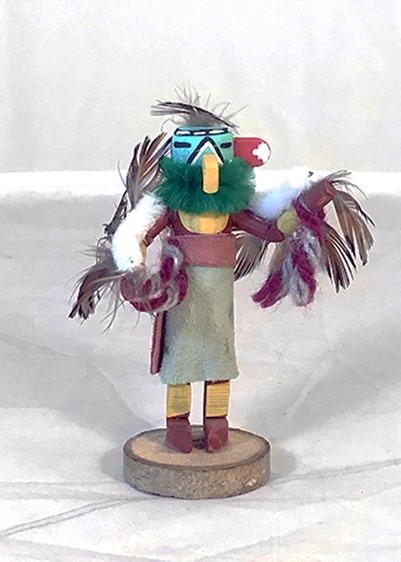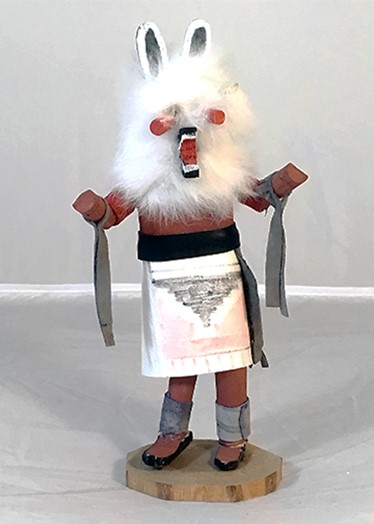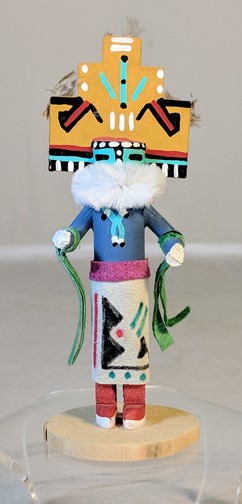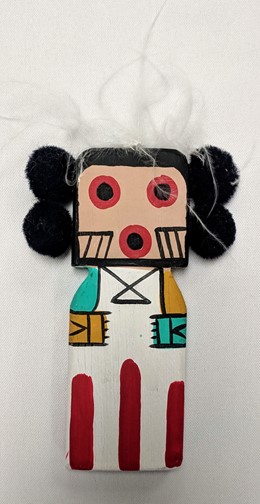Native cultures of the American Southwest produce three main kinds of Kachina figures. The Hopi and the other Pueblo cultures produce tithu figures, which are religious, educational toys that portray Kachina spirits, the benevolent spirits of the Pueblo religion. The tithu are carved by men in the community and given to girls at the beginning of the Kachina season, to help them learn about the many different Kachina spirits. As all of the men of the community–not just the artists–make tithu, these figures are carved from a single piece of soft cottonwood tree root and typically crafted in a simplified, blocky form, with the arms and legs made close to or attached to the body. While occasionally feathers may added to these figures, their features are otherwise almost exclusively simple and painted on. As important ritual objects, these figures are not made or intended to be sold to outsiders.
Another main version of Kachina figures are the Kachina dancer figures, which are made by Navajo/Diné artisans to portray Pueblo dancers wearing Kachina masks and regalia. The Navajo/Diné do not practice Kachina veneration, and these figures are therefore not made as educational toys, but exclusively as artworks for the tourist trade. Dancer figures range from simple painted wooden figures that are assembled from multiple pieces of wood, to elaborately carved and painted, naturalistic figures with added features made from leather, fur, feathers, and other materials. The Navajo/Diné also make and sell a type of figure called a Yei, which is often confused with Kachina figures, but this figure represents a Holy Person of the Navajo/Diné.
The third main kind of Kachina figure is the Kachina spirit figure, which is a sculpture made by Native American Southwest artists that consists of a creative, highly skilled portrayal of a Kachina spirit. These figures are artistic endeavors, and they may be made in any material – from wood to stone to ceramic – and they are typically made for sale in the art market.

Navajo/Diné culture
Early 21st century
Wood, feathers, leather, pipe cleaners, and pigment, L. 5 cm x W. 3.5 cm x H. 8.5 cm
BFPC collection #2003.20a
This Kwahu Kachina figure portrays a Hopi dancer wearing the mask and regalia of the eagle spirit. To the Pueblo peoples, the eagle embodies elements of strength and power, and the Kwahu Kachina spirit acts as a leader over the skies and brings messages to and from the heavens. The Hopi dancer portrayed in this figure is likely from the Third Mesa region, as it wears the red- and yellow-painted body of a Third Mesa Kwahu dancer.

Navajo/Diné culture
Early 21st century
Wood, faux leather, fur, and pigment, L. 9 cm x W. 5,5 cm x H. 20 cm
BFPC collection #2003.20b
This Kocha Honau Kachina figure clearly portrays a dancer, as the figure’s right leg is attached with swinging joint that allows the figure to “dance.” Kocha Honau is the bear spirit, and in the American Southwest, the bear is a symbol of great power that is believed to cure serious ailments. Kocha Honau is also an important character in Hopi mythology; rather than staying in one of the three underground worlds with the other ancestors, the bear spirit ancestor entered the fourth world, which is known as Earth, and where the Hopi live today.

Navajo/Diné culture
Early 21st century
Wood, feathers, leather, pipe cleaners, and pigment, L. 4.5 cm x W. 4 cm x H. 11.5 cm
BFPC collection #2003.22
The Hemis Kachina spirit is among the most important of the many Pueblo Kachina spirits that represent clouds, and the stepped, geometric headdress of the Hemis Kachina mask is the stylized representation of a tall cloud. Cloud Kachina spirits are numerous because clouds bring rain, which is particularly important for life and good crops in the dry desert regions of the American Southwest. The Hemis Kachina dancer appears as one of the dominant figures of the last dance of the Kachina season.

Navajo/Diné culture
Early 21st century
Wood, acrylic pompoms, feathers, and pigment, L. 6 cm x W. 1 cm x H. 9.5 cm
BFPC collection #2003.21
This figure is made in the form of a puch’tihu, or cradle figure, which is a simple figure carved out of a flat piece of wood and painted with basic features; these are typically given to a Hopi girl when she is about two years old. Puch’tihu figures are more symbolic than functional, as the girls are too young for instruction about Kachina mythology, but the figures do serve to familiarize the girls with Kachina imagery. As this figure has the added features of pompoms and feathers, this is not a functional puch’tihu, but a Navajo/Diné interpretation of the figure.

Navajo/Diné culture
Early 21st century
Wood, feather, and pigment, L. 3.5 cm x W. 1.8 cm x H. 7.8 cm
BFPC collection #2003.17
Often mistaken for Kachina figures, Yei figures are actually representations of Holy People, which are Navajo/Diné spirit deities. The Navajo/Diné nurture a belief system that is centered on all aspects of the universe, where mythologies uncover the truths of their world. Within this world, the Yei are benevolent beings that bring healing powers to the Navajo/Diné.
For more information, you may contact the researcher(s) noted in the title of this exhibit entry, or Dr. Billie Follensbee, the professor of the course, at BillieFollensbee@MissouriState.edu
